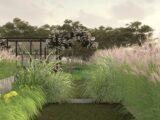Struggling to keep your indoor spaces lively? Discover the secret to greenery in dim corners with the best low light indoor plants. These plants brighten up any room effortlessly. Whether for air-purifying or easy maintenance, this guide shows you the perfect low-maintenance indoor plants for your space.
Unlock nature’s power and enhance your living or work area with the best low light houseplants. These plants thrive in shady spots and add lush foliage and striking blooms. They bring a serene and natural feel to your space, improving air quality. Get ready to see how these indoor plants dim light options make your space feel like the outdoors, even with low light.
The Importance of Low Light Indoor Plants
Low-light plants are key to a peaceful and refreshing indoor space. They make your rooms look better and bring many benefits that boost your health.
Air-Purifying Benefits
Low-light plants clean the air by taking in bad toxins and giving out oxygen. This makes the air inside your home or office much cleaner. Plants like Dracaena and Sansevieria are great at removing harmful substances from the air.
Creating a Serene and Natural Ambiance
These plants also make any area feel calm and connected to nature. Being around greenery can lower stress, help you relax, and make you feel more peaceful. Adding these plants to your space can make it a calm retreat.
Low-light plants are great for improving air quality, adding a natural feel, or just enjoying the company of plants. By placing them in your home or office, you get to enjoy the many perks of benefits of low light plants, air purifying plants for low light, and plants for relaxation low light.

plants low light indoor: Varieties to Consider
Looking for the best plants for low-light indoor spaces? Consider the lush Philodendron ‘Lemon Lime’ or the air-purifying Variegated Spider Plant Reverse. These plants come in various forms and textures, making your spaces better.
The Peace Lily stands out with its white flowers and clean air. The Janet Craig Dragon Plant is nearly indestructible, perfect for low-light spots. These plants can survive tough indoor conditions.
For color, the Begonia offers many shades like burgundy and green. The Parlor Palm and Staghorn Fern add beauty with their unique leaves. They’re great for low-light areas.
| Plant | Light Requirements | Size | Price Range |
|---|---|---|---|
| Philodendron ‘Lemon Lime’ | Low to medium indirect light | Up to 20 feet long x 3 to 6 feet wide | $22 – $48 |
| Variegated Spider Plant Reverse | Tolerates low light | 1 to 2 feet tall x 1 to 3 feet wide | $29 – $48 |
| Peace Lily | Tolerates low light | 1 to 4 feet tall x 1 to 4 feet wide | $27 – $37 |
| Janet Craig Dragon Plant | Tolerates low light | 12 to 36 inches tall x 6 to 36 inches wide | $140 |
| Begonia | Prefers shade to prevent fading | Varies by variety | $22 – $68 |
| Parlor Palm | Tolerates a variety of light conditions | 2 to 6 feet tall x 2 to 3 feet wide | $32 |
| Staghorn Fern | Tolerates indirect and low light | Varies by variety | $22 |

These plants are great for air quality and adding a natural feel to your space. Whether it’s a corner or a whole room, these plants will do well and make your space better.
Choosing the Right Plant for Your Space
When picking the perfect low-light indoor plant, think about your space’s unique features. Look at the lighting – do you have north-facing windows, a shady corner, or a dim office? This helps you pick plants that will do well in the light you have. Also, consider the room’s size and the look you want to achieve to make sure the plant fits in.
Assessing Light Conditions
The amount of natural light your indoor space gets is key when choosing low light plants. Some plants, like Snake plants and Chinese Evergreen, can handle a lot of light or very little. Others, such as Ivy and Cast Iron Plant, do best in low light. Knowing your space’s light levels will help you pick the right low light plants.
Considering Room Size and Aesthetic
The size of your room and your decor style matter when picking best low light plants for room size. Small spaces are perfect for plants like Peace Lily and Tradescantia Zebrina. Bigger areas suit plants like Parlor Palm and Philodendron. Think about how the plant’s size and look will fit with your space’s style.
| Plant Variety | Light Requirements | Size Range |
|---|---|---|
| Snake Plant (Sansevieria) | Low to Bright Indirect | 1-4 feet tall |
| Chinese Evergreen (Aglaonema) | Low to Medium | 1-3 feet tall |
| Ivy (Hedera) | Low to Bright Indirect | Trailing vines up to 10 feet long |
| Cast Iron Plant (Aspidistra elatior) | Low to Medium | 1-2 feet tall |
| Peace Lily (Spathiphyllum) | Low to Bright Indirect | 1-3 feet tall |

Care and Maintenance Guide
Caring for low-light indoor plants is key to their health and beauty. It’s important to pick the right soil and fertilize them correctly. These steps help your plants do well in dim spaces.
Watering low-light plants right is crucial. They like moderate moisture and can’t handle too much water. You also need to keep an eye on the temperature, humidity, and light they get.
Watering and Soil Management
Low-light plants need water less often than plants that love the sun. Make sure the soil dries out a bit between waterings. Too much water can cause root rot and mold.
Use a special potting mix for low-light plants. This mix is light and drains well to stop water from pooling.
Fertilization and Repotting
Feed your low-light plants with liquid fertilizer during the growing season. Choose a balanced, weak solution and follow the directions on the label.
Repot your plants every 12-18 months to keep them strong. Pick a pot that’s a bit bigger and fill it with fresh soil. This helps their roots grow and keeps them healthy.
Lighting and Temperature
Low-light plants need some light to survive. Place them near a window with soft light or use grow lights. This helps them get the light they need.
Keep the temperature steady, between 65-80°F (18-27°C), for your plants. Don’t put them where it’s drafty or near vents. Sudden changes in temperature can hurt them.
Follow this guide to keep your low-light plants happy and bright. With the right care, they can make your home beautiful for years. Remember, a little effort and knowledge can make your plants thrive, even in dark spots.
Transforming Your Indoor Spaces
Adding low-light indoor plants to your home and office can change everything. These tough plants make your home decor look better. They bring in green colors and a bit of nature to dark spots. You can put them in the center or let them flow from shelves, making your spaces feel alive.
Enhancing Home Decor with Greenery
The Staghorn Fern and the lush Dracaena Torch plant are great for adding a calm, natural feel to your home. You can put them in bedrooms, bathrooms, and entryways. They fit right in with your decor and make everything look better.
Embracing Nature in the Office
At work, these easy-care plants create a peaceful and refreshing space. They help you stay productive and feel good. Plants like the Snake Plant and the ZZ Plant are perfect for offices. They let you bring nature inside, even in busy cities.
Use low-light indoor plants to change your indoor areas for the better. See how nature can transform your home and work.
Expert Tips and Recommendations
Exploring low-light indoor plants can be both rewarding and challenging. Experts offer valuable insights to help you. They share tips on light, water, and care for these plants. They also suggest the best plants for your indoor spaces.
Plant experts recommend choosing the right plants for your space. They suggest plants like the Snake Plant and ZZ Plant for beginners. The Pothos plant is also great for low light and fits well in many rooms.
With expert advice, you can turn dark spaces into beautiful, green areas. These tips can improve air quality, create a calm atmosphere, or just make your home look better. Experts know how to make the most of low-light plants.



